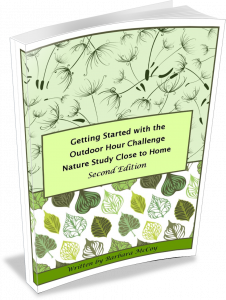“The making of drawings to illustrate what is observed should be encouraged. A graphic drawing is far better than a long description of a natural object.”
Handbook of Nature Study, page 13
As your family makes progress with their nature journals, you will find that there is a desire to start making things look a little more realistic. I thought we would take this week to challenge ourselves to practice drawing flowers with some help with internet tutorials.
Please remember that the nature journal is not the place to give drawing instruction but you could use the tutorials during your art time and then gently remind your children when it comes time for a nature journal that they can incorporate some of their new drawing skills if the opportunity arises.
I would suggest that if you have younger children, take a few minutes to educate yourself first and then share with them little hints as they try to draw garden flowers. This is a perfect opportunity for you to model positive behavior about your own sketches, showing how to make your nature journal an expression of what you found interesting during the Green Hour. If your children are a little older and you are comfortable with them following the tutorials on their own, the link below is perfect for them.
Here is a link to get you started:
HowStuffWorks: How to Draw Flowers and Plants
This is a fantastic page that lists common garden flowers and how to draw them step by step.
Make sure to bookmark this tutorial page for future reference. You could use the lessons as you progress through the next few weeks during your art or sketching time as a way of learning the techniques of drawing flowers in your nature journal. If you start with this challenge and draw at least one flower in your nature journal every week until the garden focus is over, you will have five flower sketches completed. Wouldn’t that be great? Remember no one else needs to see your drawings….we would love it if you would share but you can keep them private too.
“The book should be considered the personal property of the child and should never be criticized by the teacher except as a matter of encouragement; for the spirit in which the notes are made is more important than the information they cover.”
Handbook of Nature Study, page 13
I guarantee you if you start working in your nature journal, your children will be more comfortable drawing in theirs too.
“As soon as a child is old enough, he should keep his own nature notebook for his enjoyment. Every day’s walk will give something interesting to add-three squirrels playing in a tree, a bluejay flying across a field, a caterpillar crawling up a bush, a snail eating a cabbage leaf, a spider suddenly dropping from a thread to the ground, where he found ivy and how it was growing and what plants were growing with it, and how ivy manages to climb…..The skill of drawing may be addressed in some other way, but not in his nature notebook, that should be for him to fill as he sees fit.” Charlotte Mason volume 1, page 54-55
Outdoor Hour Challenge #15
How to Draw Lesson-Flowers
1. Read pages 13-15 in the Handbook of Nature Study-The Field Notebook. This will refresh your memory about what is the purpose and aim of the nature journal.
“Nature-study offers the best means of bridging the gap that lies between the kindergarten child who makes drawings because he loves to and is impelled to from within, and the pupil in the grades who is obliged to draw what the teacher places before him.” Handbook of Nature Study, page 17
Keep all this information in your mind as you gently go about your nature study time and then encourage journal drawing.
2. Take your 10-15 minute outdoor time to look for some garden flowers that you can draw in your nature journal. The object this week is to find something that sparks your child’s interest and that he desires to record in his journal. If it is a flower, great. If it is something else like a spider or a bird, allow them to draw that instead.
Here are a couple of my favorite how to draw flower books that you will love!
Please note these are Amazon.com affiliate links to products I have used and loved!
3. Give an opportunity for a nature journal entry, work on drawing another garden flower in your nature journal. If you are growing seeds, use this time to record their growth perhaps measuring and recording the plants height or counting the number of leaves it has so far. All of these subjects make great additions to the nature journal.
4. Add any new flowers to your list of garden flowers. If you are making field guide cards for your garden flowers, add another card this week.
5. Add any flowers you collected to your flower press. We have found you can add another sheet of paper and another cardboard sheet to the mix and you will have a multi-layer press. Check on your flowers from last week and see if they are ready to go into your nature journal. See challenge 14 for more information.

This challenge is part of my Garden Flowers ebook. This ebook has ten garden related challenges that will walk you through a study of garden flowers using the Handbook of Nature Study. In addition to the challenges already written, there will be more photos, nature journal examples, book lists, and totally new notebook pages designed to go with each of the Garden Flower Challenges.









































